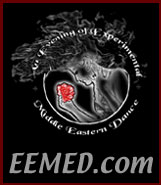|
 |
|||||||||||
|
|
||||||||||||
|
X-MED 2006 Review "X-MED 2006" Chronicles Oct/NovDec 2006: 28. One of the more daunting challenges facing a belly dancer is moving beyond the basic shimmy and hip bumps into creating art, into using the body as a tool to sculpt emotions. We are taught only to smile, ignoring the passions that first drove us to dance, forgetting the fury and lust and humor and pain, unable—or perhaps afraid—to dance to our own hearts. X-MED, an intensive 3-day seminar in Experimental Middle Eastern Dance, was established to allow dancers to learn and explore various structures, processes, and techniques needed to develop their artistic expression. Created by Amara, director of Ya Helewa! and An Evening of Experimental Middle Eastern Dance, Djahari and Sa' Elayssa, directors of Desert Sin, and Anaheed, director of Perfumes of Araby Dance Company, the workshop is designed to show dancers how to discover new ways to free themselves within Middle Eastern dance. The workshops included dance, lecture, make-up and costume design, performances followed by a question and answer session, lighting, story telling, and more. They were taught by Amara, Djahari and Sa' Elayssa, and Anaheed. In addition, the weekend included performances by a number of artists, each with the purpose of illuminating some aspect of the workshop. (See http://www.eemed.com/xmed/ for a complete list.) One of the recurring topics was critiquing our own work, either through video or performing for our peers. In our workshops, groups of dancers were told "You are sea creatures" or "You are Cleopatra,” and we tried to immediately convince the audience of what or who we were. We gave spontaneous performances on a stage to practice using props, stage layout, and lighting in creative ways to express such emotions as fear and being timid. Dancers discussed their rules of belly dance and talked about how those rules could be broken. We explored emotions through costuming and make-up, with each dancer’s final make-up design applied to his or her face to see how a drawing translates into stage make-up. Dancers practiced meditation, facial vocabulary, bodily expressions, and non-narrative and narrative story telling. These exercises left no opportunity to doubt ourselves. We adjusted to the other performers, to the requests of the teachers, and to the staging and props. We had to find new ways to express ourselves outside our normal boundaries, to express our own emotions without using our standard belly dance repertoire. One of my favorite workshops was the last one, "Storytelling Through Dance.” In this workshop, small groups of us had only a few minutes to create a performance from a story. Those with aptitudes for story telling, directing, make-up, choreography, and performing made decisions based on group input. We rehearsed it once, and it was show time. We presented the vignette to our classmates—improvising where we had to--trying to apply all that we had learned, knowing that, although we had never before performed together, we had to give our audience a polished performance. After our show, we stood quietly listening to our audience’s critique, smiling when we saw that we had reached them and inwardly cringing when they described their confusion. We were then given the opportunity (as I remember, about 5 minutes) to revise the performance, expanding what worked and changing what didn’t, and we again performed it. The experience illustrated everything we had been taught during the weekend: each group’s performance was better due to the critique and analysis of the other dancers; by finding our own limits and breaking them, we created a performance that improved with each telling; using our body and face, we can convey our and our character’s emotions; our own disparate dance styles can be combined to create a unified dance. The challenge now is to take these lessons into the real world, to remember that we are the storytellers, that the audience looks to us to recognize themselves and their own stories. Dance is the only art of which we ourselves are the stuff of which it is made. |
